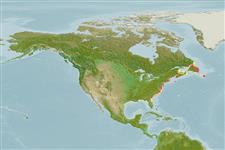Common names from other countries
Environment: milieu / climate zone / depth range / distribution range
Écologie
; profondeur 11 - 16 m (Ref. 1239). Subtropical
Distribution
Pays | Zones FAO | Écosystèmes | Occurrences | Introductions
Western Atlantic: USA and Canada. Tropical to polar climates of northern hemisphere.
Length at first maturity / Taille / Poids / Âge
Maturity: Lm ? range ? - ? cm Max length : 0.2 cm TL mâle / non sexé; (Ref. 1239); common length : 0.1 cm TL mâle / non sexé; (Ref. 1239)
Found in the littoral zone. Active hunter (Ref. 111265).
Life cycle and mating behavior
Maturité | Reproduction | Frai | Œufs | Fécondité | Larves
Members of the class Aplacophora are mostly hermaphroditic. Life cycle: Eggs hatch into lecitotrophic larvae which later develop into adults.
Morse, M.P. and J.L. Norenburg. 1992. (Ref. 1239)
Statut dans la liste rouge de l'IUCN (Ref. 130435)
statut CITES (Ref. 108899)
Not Evaluated
Not Evaluated
Menace pour l'homme
Harmless
Utilisations par l'homme
| FishSource |
Outils
Plus d'informations
Taille/Âge
Croissance
Longueur-poids
Longueur-longueur
Morphologie
Larves
Abondance
Sources Internet
Estimates based on models
Preferred temperature
(Ref.
115969): 3.1 - 23.7, mean 7.2 (based on 168 cells).
Vulnérabilité
Low vulnerability (10 of 100).
Catégorie de prix
Unknown.
